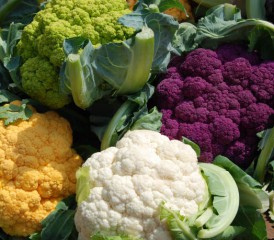Amazing Anti-Cancer Powers of Cauliflower

You may not have heard of the Brassica family of vegetables, but you’ve certainly seen them on your dinner plate and salad bowl.
While the family has more than 3,000 different veggies, only a handful are edible, including Brussels sprouts, cabbage, kale and broccoli.
Another veggie in that family is cauliflower. It comes in orange, green and purple, but the most common variety is the white cauliflower. You may not think of a white-colored vegetable as a nutritional powerhouse, but in fact, it contains compounds that inhibit cancer growth and promote the death of cancer cells, while sparing healthy cells.
Research shows that people who consume cauliflower and other cruciferous veggies have a lower risk of developing cancer.
In fact, a French research team in 2014 reported an anti-cancer vegetable compound called PEITC. The National Cancer Institute shows PEITC is found in cruciferous vegetables, including cauliflower. PEITC could have interesting therapeutic benefits for pleural mesothelioma patients.
Those researchers confirmed PEITC and the popular chemotherapy drug cisplatin make a powerful, cancer-fighting pair. While research shows both can kill mesothelioma cells on their own, the study shows they are even more effective when combined.
Cauliflower Is a Superfood
The consumption of cauliflower dates back to the 12th century or earlier. It originated in the Middle East. Today, cauliflower is found across the globe. California is one of the top producers.
Cauliflower is considered a superfood because of its nutrient-rich content. It is high in fiber, and vitamins B and C. It also contains high concentrations of carotenoids (antioxidants) and glucosinolates.
Although both of these compounds have anti-cancer effects, the glucosinolates have generated the most interest.
Cutting or chewing cauliflower releases compounds called isothiocyanates (ITCs), which are products of glucosinolates and inhibit cancer growth.
The compounds in cauliflower and other vegetables in the Brassica family can also:
- Protect cells from DNA damage
- Produce anti-inflammatory effects
- Induce cell death
Scientists are also looking into the protective effect ITCs may have when used in conjunction with chemotherapy.
A government program known as MyPlate recommends 6-7 daily servings of vegetables.
The Linus Pauling Institute, a research group focused on health maintenance, recommends a weekly serving of five cruciferous vegetables.
Growing and Storing Cauliflower
Cauliflower is a cool season vegetable that prefers a sunny location and well-drained, fertile soil. Avoid extreme temperatures in the heat of the summer.
Look for large, white compact heads when choosing cauliflower. Don’t purchase if it has spots, dull colors or small flowers. It will keep in the refrigerator for up to a week in a paper or plastic bag.
Many Ways to Prepare Cauliflower
Cauliflower is a versatile vegetable that can be incorporated into a diet in a variety of ways, including:
- Steamed, pureed and blended into soups
- Steamed and mashed as a mashed potatoes alternative
- Served as a crudité with a dip
- Roasted in the oven or grilled as a side dish (add a touch of parmesan for a truly tasty dish)
- Cut into florets and pickled
- Don’t forget to use the stem and leaves. These are also nutritious and edible. Blend them into soups.